I took this photo a while back while I was in Borneo. I was looking through my photos and remembered how beautiful the sunset was that night. This photo is at a resort, but they let you go in even if you are not staying there. If only this was a tropical island that I could live on (with wifi, of course).
How to Travel Around the World
Traveling around the world is something that most of us dream about but never actually do. We love the idea, then after we think about it for a little bit we get discouraged by the cost, the time it will take, or other excuses. Yes, they are excuses. Everyone can travel the world. It’s rather easy and cheaper than you think. Here’s how to do it.
Transportation
Traveling around the world is actually rather cheap. The biggest expense is usually accommodation. You might think it’s the flights, but who says you have to fly? I suppose if you live on one side of the Atlantic and want to go to other side you’ll have to fly. In that case, the ticket prices are usually in the range of $1000. That will be the biggest flight expense you face.
You can also take buses around North America and it’s really easy to take buses around Central and South America. If you are in Europe, trains and buses are very cheap. In Asia they are extremely cheap. I recently took a bus to Phuket from Bangkok for $20 and that was a VIP bus that included dinner (at the rest stop). You can easily find buses for $4—no joke.
If you are hell-bent on flying, most flights are really cheap outside of the United States. Rarely do I pay more than $100 for a flight anywhere else in the world, and in Europe and Asia I find flights for $30. Traveling around the world is quite inexpensive if you do it in small jaunts.
Transportation Travel Tip: Do not buy an around the world ticket or return (round-trip) ticket. That goes for every mode of transportation. Buy a one way ticket from your destination. When you are ready to move on, buy the next ticket. Some flights will be cheap if you buy them far in advance, but that is rare and not worth the lack of flexibility. Flights, trains and buses are almost always available, especially with a couple of days notice. That’s all you need to plan your travel.
Accommodation
Accommodation is likely to the be the biggest expense in your world travels. There are easy ways to find cheap places to stay, even if you want a private room and bathroom. Most hostels have private rooms for just a couple of dollars more than a shared room. Of course, if you choose a shared room it’s even cheaper.
Typically I find private rooms with an en suite bathroom for $10 or less. In most places they’re ever cheaper. I splurged in Siem Reap, Cambodia a week ago and stayed at an absolutely wonderful place for $13. It was nicer than most four star hotels. Check out Hostel Bookers or Hostels.com, as well as regional networks like Agoda, for options, prices and reservations.
Other options for cheap accommodation include AirBNB, home-stays, house-sitting, meeting new friends on the road and staying with them for a night or two, and even traveling at night on buses (free). You can even rent an apartment. I rent in Bangkok for 5000 baht a month, about $165, and there are even cheaper places. Even if you don’t plan on staying a full month, renting can save a lot of money. Just choose the right places, usually not those catering to tourists since they will be more expensive.
The key is to keep your options and mind open to the possibilities. You will find that most hostels are really nice, quiet and clean. You don’t have to stay at an expensive resort or big chain hotel. In fact, avoid those. They are not much fun and way over-priced.
Accommodation Travel Tip: Avoid booking your rooms too far in advance or for long periods of time when you plan to travel around the world. Usually I will book a room for only one night. If I like it I can almost always extend my stay. If I don’t like it, I can find another place. Finding rooms is rarely a problem and you give yourself flexibility when you don’t book too far in advance or for a long period of time. If you plan on staying somewhere for a long time, ask for a discount. Most hostels will give you a discount if you are going to stay with them for one or two weeks, and especially longer.
Eating
You might think that eating is expensive, but it really isn’t. Don’t be afraid to try to local cuisine. It is safer than eating Western food because the locals know how to prepare their own cuisine and how to keep it from going bad. Western food usually requires refrigeration and special handling, not to mention a specific type of preparation. Something is likely to go wrong during that process. That doesn’t happen with the local cuisine.
Avoid eating at restaurants, especially those catering to tourists. They are over-priced and the food usually isn’t very good. Eat where the locals eat. In Southeast Asia it’s dirt cheap to eat. Street vendors offer great food that is cooked right in front of you for about $1 or less. I’ve never gotten sick from eating at a street stall. I can’t say the same for restaurants.
If you like to go out to bars, then visit a local bar. Nightclubs and bars that cater to tourists can be expensive and often locals aren’t even allowed in. Instead, go to the local joint. It’s usually far more fun, you will meet interesting people, and the prices are far, far less than what you would pay at tourist bars. Keep in mind that the local hooch is often much cheaper than imported alcohol. Get the local beer and buy a large bottle instead of several regular sized bottles, and you save a lot of money.
Eating Travel Tip: Don’t be afraid to eat the local cuisine and try new things. Some of the best food I’ve had has been at places you might be a little worried about, even though there’s no reason to be. I had amazing fish in Nicaragua at a local hole in the wall with a dirt floor—our hotel staff didn’t want us to go, but it was great!. I’ve eaten the best curries from street stalls throughout Asia. The local cuisine is far tastier and healthier than eating restaurant crap.
Sites & Activities
Most of the really fun things to do around the world are free. Just experiencing the culture, people watching or lounging around. It pays to make friends with the locals. Not only is it a great way to meet people and experience the culture, but the locals usually know what to do, where to go and how to do it cheaply.
Of course, some attractions are going to cost money and there’s no getting around that. Angkor in Cambodia is $20 a day (though I think they should charge more, but that’s another story). Usually you’ll save money if you plan out the itinerary yourself instead of going through a tour agency. Once in a while that’s not the case, so I suggest doing a bit of research.
When I was in India with my friend, we saved a ton of money by going to Ellora Caves on our own. If we did it with the typical tourist package it would have been many times more expensive. Turns out it was a simple bus ride out to the caves for about 50¢ instead of the $50 for a car and driver. We had a lot more fun figuring it out, having the locals help us, and doing the tour on our own schedule.
Sites & Activities Travel Tips: Consider several options before deciding what to do. Sometimes tour agencies offer a good value. More often than not, you can do it yourself more easily than you think and save a lot of money. Your hostel can help you out with both options. Ask around and check things out. Remember, doing it yourself is a lot more fun!
Travel Slow
This is something I cannot stress enough. Travel slowly if you want to save money and enjoy yourself. Staying in one place for a longer time not only saves you a shit load of money, you also really get to know and understand the culture. I’ve met amazing people from all around the world because I stayed put for a longer time.
Sometimes I have to travel fast. There is nothing wrong with that, per se. I don’t always have the luxury of staying in one place for long but still want to see the sights. What I’ve found when I travel fast is that I don’t meet as many people and don’t really get to know the place. Sure, I see the sights but I don’t really experience them. Travel slow!
Stay Flexible
As I’ve mentioned several times, when planning your around the wold trip don’t plan out your full itinerary down to every last detail. Keep it fluid and flexible. You know there are countries you want to visit and sights you want to see, so definitely plan to go to those places. Just leave the when open.
I can’t tell you how many times I’ve visited a place and wanted to stay longer. Sometimes I’ve wanted to leave sooner. With flexible travel plans that isn’t an issue. Only once have a really run into a problem by being flexible. I was in Agra, India and wasn’t able to get on a (decent) train out. I ended up using a driver and it turned out to not be too expensive, so it all worked out. If I really needed, I could have taken a lower class train. The point it, the flexibility is worth far more than maybe encountering a little hiccup once in a while.
You may also find out about a place you didn’t know about and want to visit. Or you meet some great people who are going somewhere not on your itinerary and you want to go with them. Flexible travel plans let you change where and when you are going without any problems. You will have a far better time if you keep everything flexible.
The Budget
Since someone will ask, I’ll give you my typical budget. I tend to spend more than a typical backpacker and less than an expat. The amounts are averages for a month.
Accommodation: $165 (if at hostels/hotels, I stay around $10 a day or less)
Utilities & Internet: $60 (not part of hostel/hotel stays usually)
Transportation: $100
Food: $150
Bars: $150
Sites, Attractions, Entertainment: $200
Total: $825
Depending on how you like to travel and the level of comfort you need, you can spend more or less. Last month I only spent $615, even though I went to Phuket and Cambodia. A few month before that I spent $1200, but I went to Burma and had limited time so I took a lot of flights. I have friends that spent considerably less than that. This month it looks like I will spend $515 (the amount I pulled from the ATM, 15000 baht). One friend of mine spends about $450 a month. Another spends well over $2000. It’s really up to you.
If you stay at hostels, eat the local cuisine, and travel slowly then you can save a lot of money while traveling around the world. Keep your travel plans flexible so you can change your itinerary at will. This rarely, if ever, will add the cost of your travel, and will give you the opportunity to stay and explore places you find you love and leave places you don’t enjoy. Most important, keep an open mind about and be willing to experiment and try new things. Traveling around the world, even if for three months, six months, or a year, it will be the best experience you’ll ever have.
Weekly Photo: Butterfly at Phnom Kulen National Park
There were butterflies everywhere at Phnom Kulen National Park. Literally hundreds of them were flying around. Many were orange, but there were a few that were blue and green like this one. It took quite a bit of patience to wait for the butterflies to stop long enough to take a photo. I waited about 10 minutes for this one. I had another one that was great, except my friend walked right in front of me just as I snapped the photo. No names will be mentioned, however. =)
Getting to Siem Reap from Bangkok (and back again)
Several people have asked me how to get to Siem Reap, Cambodia from Bangkok and back again. While it’s not actually that difficult, there are a few things to be aware of when making the trip to Siem Reap so you avoid some pitfalls that other travelers have encountered.
The first thing I suggest is give yourself plenty of time. Everything takes longer than you are told. Buses will leave late, there will be several stops and lots of waiting. There is nothing you can do about this, it’s just par for the course in SE Asia.
Bangkok to Siem Reap
Whatever you do, don’t take the minibuses from Khao San Road in Bangkok to Siem Reap. You will just get screwed and it will take 20 hours or more to get to Siem Reap, assuming you actually make it.
Just go the central bus terminal, Mochit Station. You can take the BTS to the station and then pay 20 baht for a motorcycle to the bus station itself. If you are not comfortable with this, take a taxi. Remember, traffic can increase the cost, but if you use the meter you will probably end up paying around 150-200 baht, depending on where you are coming from.
There is no need to reserve bus tickets in advance. Buses leave often, about every half hour or hour starting around 7 or 7:30 in the morning. The schedule changes often, though it always remains roughly the same. You will ask for a ticket to Aranyaprathet. Expect to pay about 230 baht or so and for the ride to take about 4 hours. The bus will stop several times, but it’s not for you to rest. You will see officials get on the bus and look at IDs. Typically they are not interested in foreigners, but have your passport ready just in case they want to look. They are looking for non-Thai (and non-white) people to harass or extort money from.
You will arrive at Aranyaprathet and there will be a lot of tuks tuks that want to take you to the border. Expect to pay about 80-100 baht to the border. If you can get it for less, great, but 80 baht is a fair price.
The tuk tuk drivers will take you to a nice white building that has a big sign out front that says “Visa Border.” That you should tip you off that something is not right. I mean, what is a visa border? This is a scam. You ask the driver to take you to the real border, and some will, but most will still run through this little operation because they get a kick back. When the tuk tuk arrives, don’t get out. Just say “No!” firmly. They will let you go on your way and the tuk tuk will take you very short distance to the border.
There will be lots of people who want to help you. Most of them just want you to use their minivan service to Siem Reap, so they are actually somewhat helpful even though you don’t need their help. You will go to your left and enter Thai immigration to get stamped out of Thailand (don’t forget this or you will find coming back nearly impossible).
Once you are out of Thai immigration you head across the bridge. You will be asked to complete a quarantine form in Cambodia once you reach the other side of the bridge. This is normal and there are no fees involved. From there turn right to get your visa. The cost is $20 plus 100 baht if you don’t have a photo. Complete a form and give them the money. They might ask for more money, but politely decline. You can point to the signs that indicate the prices. Just remain firm and they will relent quickly.
When you have your visa in hand, walk up the road to the Cambodian immigration office (also on the right side—you’re now in Cambodia where they drive like most of the world, on the right side). You will complete an entry form and get stamped into the country.
Now you need to get from Poipet to Siem Reap. There is a government bus that is free that will take you to the bus station. There are a few options. You can hire a taxi/private car to Siem Reap for around $50-70. A minibus is about $65, so if there are several of you to split the cost that is a good and comfortable option. The prices are negotiable but in all the times I’ve gone, I’ve never been able to negotiate any prices once they tell you what it is. I’m good at negotiating, but maybe you are better. Finally, there are actual minibuses that leave when they are full and cost about $10-12. The price is posted inside where you buy the ticket and the price is not negotiable.
Typically I try to find a minibus before I reach the bus terminal so that way I can leave sooner instead of waiting. I am willing to pay around $10-15 in order to go a bit more quickly. I’ve waited at the terminal for hours before and it’s not fun. Your own minibus or car is also faster. There are fewer stops (though you will hear about how the tires need a rest or the driver needs a rest—just give him 5 minutes and then ask to be on your way). You will end up in Siem Reap in about 2-2½ hours. They will probably switch you over to a tuk tuk to take you to your hotel. This is not included if you buy the regular minibus ticket at the terminal; you’ll need to find you own way to your hotel. No worries, Siem Reap is small and a tuk tuk should not cost more than $2 for anywhere in the main area.
Siem Reap to Bangkok
Getting back to Bangkok is significantly easier. There are fewer scams and you can book all the way through without the worry of getting screwed like in Thailand. All of the travel agencies and hotels can book you a ticket to Bangkok. My hotel booked mine for $12, though you can get them for as low as $8 at travel agencies (I was being lazy and my hotel staff is super awesome, so I just ate the extra $4).
You will be picked up at your hotel and taken to the bus station, which is really just a stop in the city where most backpackers hang out. Getting on the bus is a bit of a cluster since they just pour people in until its full, so try to keep an eye on your bags so you know they are on the same bus as you.
You’ll be bused to the boarder. They will ask for your ticket when you get on the bus and when you get off (they need it so they get paid). There will be a stop along the way to the border. When you reach the border they will give you a sticker. Ostensibly someone will go along with you, but it becomes a bit of a cluster. So just head for the border to get stamped out of Cambodia, then walk across the bridge (remember to switch sides since your going into Thailand). Find the line that indicates “Foreigners.” There you will get your entrance form, or if the line is short they are inside.
For most nationalities, Thailand will give you 14 days at the land border. So if you need more, get a visa in advance. Once you are through Thai immigration, wait outside. Your driver is looking for you! Believe it or not, they are keeping track and will find you if you wait and you haven’t lost your sticker. If you have, find another person and ask where you color of sticker is and they will help you.
From here you get on a song thaw and are taken to a restaurant when they make you wait for about 30-45 minutes. They want you buy something. I usually bitch and moan a bit and can get on a minibus sooner. They will pack it full, usually making another stop to pick up more people.
Thais are rather odd and think that filling their tank will cause them to get bad gas mileage, so you will make 2 or 3 stops at least to gas up before reaching Bangkok. It will take about 4 hours and the drivers are crazy, so be prepared. They will not be dropping you off at a regular bus station either. Most of them take you to Khao San Road.
Day Trip to Phnom Kulen National Park
The last time I was in Siem Reap, Cambodia I met some really great guys from Australia. We had a blast together. So when they said they were coming back to Siem Reap I had to go meet them. Siem Reap is not far from Bangkok by bus, though the journey can be a bit long with a few nuisances along the way. Nothing I haven’t dealt with before.
I’ve been to Cambodia many times and so have my friends, so were able to avoid most of the touristy stuff. We had all been to the Angkor temples before. We’d seen most of the museums. This time we just hung out it the small city center drinking and eating. There’s nothing wrong with that once in a while, though we finally started itching to do something a little more. We tried the War Museum, but that is depressing and taking only an hour.
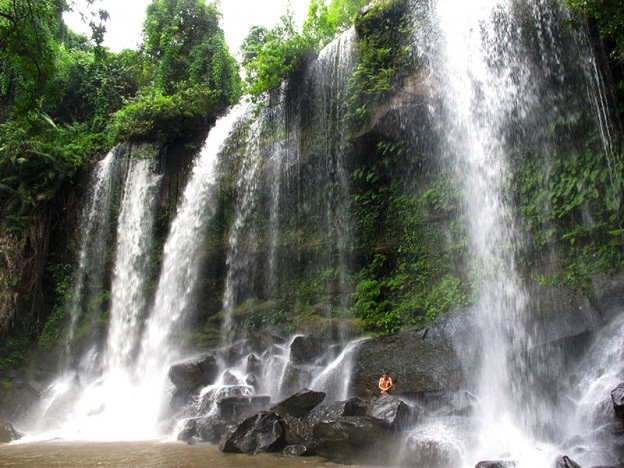
Instead, we decided to take a day trip to Phnom Kulen National Park. Phnom Kulen is about 50 kilometers from Siem Reap, out in the jungle up a winding dirt road that goes one direction in the morning and the other direction in the afternoon. It takes about two hours to get to, despite the relatively short distance. Since there were five of use, we just got a minivan for the day. That was $55 and the entrance fee is $15 if you buy from a travel agency, $20 if you buy when you get there.
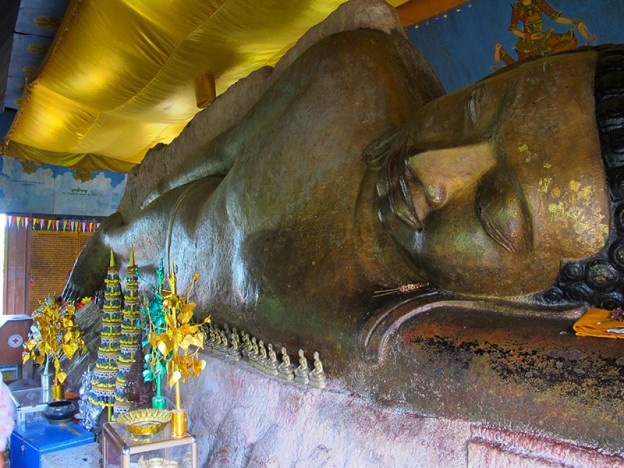
Wat Preah Ang Thom, a Buddhist temple with a reclining Buddha, was the first stop. There are hundreds of steps to climb to get to it, of course. The temple is relatively small, though it was pretty busy. Mostly locals visit; there are few foreigners. The temple dates from the 16th century as was actually Hindu before the Buddhists took it over. You can still see many Hindu carvings, mostly Vishnu (the elephant).
Nearby the temple is Phnom Kulen Waterfall. There is a small falls at the top with water flowing over flat rocks that you can walk on before it finally tumbles down the main waterfall. To get the that you have to climb down wooden stairs that are broken and missing several steps. It’s a bit dangerous, as are the slippery boulders you have to climb around to get to the actual falls. Once there, the effort is worth it. You can go swimming and climb the rocks at the base of the falls. The water has “massage fish” in it, the same fish that nibble on your feet you see in tanks outside massage parlors in SE Asia.

Because we finished with the falls sooner than anticipated and we couldn’t head back down until after noon, we decided to see the 1000 Lingas. There are carvings of phallic symbols known as linga that cover the bottom of the Siem Reap River. It’s believed they bless the river before it reaches the Angkor temples.
While Phnom Kulen isn’t an life-changing destination, it is a nice place to visit if you want to get away from the tourist hordes and just have a relaxing day trip. You’ll mostly encounter locals and the surrounding area is quite beautiful. There were hundreds of butterflies everywhere. The place was very relaxing and enjoyable.
Weekly Photo: Phnom Kulen Waterfall
The water looks rather brown, but it’s actually not so bad when you are close up. Phnom Kulen Waterfall is about 2 hour drive from Siem Reap along a windy road. You end up in the middle of the jungle, but it’s rather pleasant. There are few foreigners and the place is relaxing. A nice respite from the tourist hordes that visit Angkor.
Weekly Photo: Koh Phi Phi Don
On a day trip from Phuket, I visited Koh Phi Phi Don for the first time in four years. It’s changed quite a bit, with more tourists and touts, and more development. One thing has remained the same, though, and that’s the beauty.
Weekly Photo: Ya Nui Beach, Phuket
Ya Nui Beach is a small beach with few people around. It’s not exactly easy to get to, and its far from the regular tourist beaches most people visit. There’s a small outcropping of rocks that are fun to climb around, and you get a nice view of the little beach as well.
Relaxing in Luang Prabang
Since I was in Laos to renew my Thai visa, I decided that I might as well visit more of the country than just the capital, Vientiane. There are many destinations that seemed appealing but I couldn’t stay very long in Laos, just a couple of weeks, so I chose Luang Prabang because it is supposed to be charming and relaxing.
Well, it is! Luang Prabang is very laid back, just like the rest of Laos. The city is very clean and manicured. It feels a little less like an Asia city and little more like a small resort town. Nonetheless, it was still a really nice place to relax.
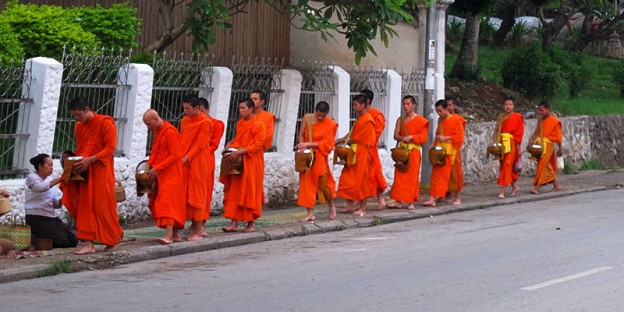
Perhaps the most famous thing Luang Prabang is known for is the procession of the monks that seeks alms every morning. I woke early to see this, though I was a bit late even at 5:45am. Still, I saw several monks walking around to get their food. I also saw plenty of jackasses shoving cameras in their faces and jumping all over the place to get a photo. That rather detracted from the whole experience.
I chose to be respectful and stuck to the opposite side of the street from where the monks walk to collect their alms. That meant my photos weren’t as good, but to be honest I was far more interested in watching the monks than taking photos.
After the watching the monks I decided to go for a walk around the city. Luang Prabang is really small and can be walked in about half an hour. I went to the market and saw some pretty crazy stuff for sell. At least that still felt like Asia, with various bugs and animals for sell. Finding breakfast reminded me that this is a tourist destination—food is not cheap in Luang Prabang.
Luang Prabang lacks the big draws of other destinations, but there are still some nice things to do. I took a day tour that included a visit to Buddha caves and Kuang Si Falls, with a short stop at a “whiskey village” that was really just a tourist trap to sell some crazy alcohol.
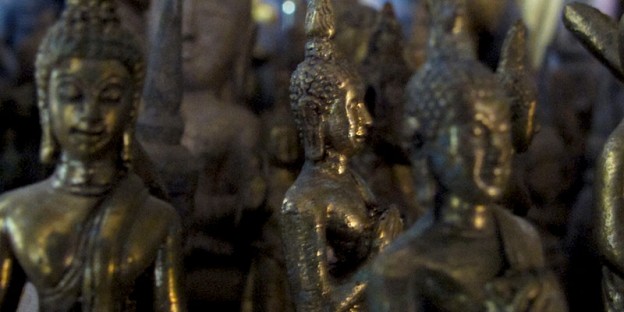
The Buddha caves are interesting, if not life changing. I think I enjoyed the boat ride along the Mekong more than the actual caves. The caves are small and require a but of hiking up steps in the sweltering heat to reach. Then it’s pretty much a bunch of small Buddha statues packed into caves. One cave isn’t even lighted so you need a flashlight.
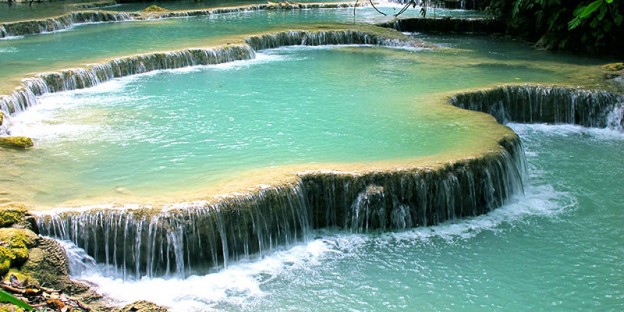
Kuang Si Falls was more interesting, if only because of its natural beauty. I was reminded of Yellowstone and Pamukkale from the calcium travertines. Usually I expect the water to be rather warm in such situations, but in this case it was rather brisk. I was only able to swim for about 10 minutes before I was shivering, even though it was well over 100º F outside. The Kuang Si Falls were touristy and filled with crazy backpacker 20 somethings, though I still enjoyed the beauty. I imagine during the rainy season the Falls are even more spectacular.
One can’t deny the charm and the natural beauty of Luang Prabang. The people are wonderful and nice, just like the rest of Laos. The city is very laid back and has a slow pace. Perhaps not the most interesting sites or the “real Asia,” but still a nice place to just relax and get away.

Weekly Photo: Sun Bear
Near Kuang Si Falls there is a Sun bear reserve established to help Sun bears that have been mistreated and cannot be returned to the wild. They are vegetarians and seem rather lazy. All they did was sleep. They even slept in hammocks, which was rather amusing. Sometimes, they just people watch, like this Sun bear. =)
